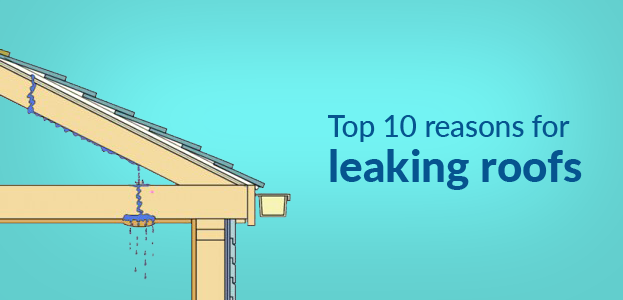
Top 10 reasons for leaking roofs – DuraRoof
June 08th, 2019
Category: All Blogs, Roofing Solutions
Your home is the definition of comfort, warmth, and happiness. However, frequent home maintenance repairs are necessary to let your homestay beautiful. Maintaining your home through a long period can take a lot of effort and time, but keeping a regular check on the simplest things can go a long way in ensuring that your home lasts longer. Among some of these problems, a leaking roof is one of the most frequent and commonly heard complaints by residents. Leaking roofs can occur in a newly built home or in an old home – it all depends on how you have maintained it. Here are some of the top reasons why leaking roofs occur, so you can detect them easily!
1. Improper Installation
Good installation is one of the key factors that contribute to the quality of your roofing solutions. Due to improper installation of shingles, or poor quality of materials used, your ceiling may eventually become subject to dark stains and leaky holes. This can be caused due to poor installation of roof membranes, roof vents, and more. During the process of installation, always ensure that products of high quality are used. If you are unable to detect the exact reason, contact a professional who may identify the exact spot and suggest a solution.
2. Old Roofs
Your roof may be built to last a long time. However, there will come a time when the roof will give in and begin to leak. This may simply be due to age and its lack of durability. Temperature changes along with age can result in leaking roofs, as roofs tend to get brittle over time. Home repairs are required to be done as soon as possible before the situation can worsen. So, if you spot a leaking roof in your house of 10 years or so, it is wise to consult an expert and get it repaired soon!
3. Punctured Roof/ Debris
Whether it is a strong blow of wind, heavy trees, or strong thunderstorms, natural calamities can cause damage to your roof. However, even if your roof has not been punctured, the debris could end up preventing the flow of rainwater. This could result in the water pooling around, eventually seeping through your walls and causing inevitable roof damage. To prevent this from happening, it is recommended to always keep the gutters clean and free from debris.
4. Lack of Ventilation
If there is not enough or adequate ventilation in your room, high moisture levels can result in leakage. This can especially happen in kitchens and bathrooms, as moisture can easily develop due to improper ventilation. Ensuring that such rooms are properly ventilated would help your roofs become free from leakage.
5. Unsealed Roof Valleys
If the roof valleys are punctured, roof leakages can occur. This can especially happen if the valley metal or the shingles are damaged. This lack of home repair or maintenance could, therefore, result in leaking roofs. Ensure that your roofs are sealed properly.
6. Roof Slope
The roof slopes in your house also play a vital role in understanding how roofs can leak. If the roof slope is shallow and not as per its requirements, water can easily seep in. this is also a warning sign that your roof is failing. If so, use a double layer of underlay material to prevent such leaks. Furthermore, guaranteeing that your roofing materials match the roof pitch, with the right installation methods, will help your roof get stronger and more leak-proof.
7. Roof Vents
Any holes or gaps around roof vents ought to be sealed well, to prevent any leaks. The gaskets surrounding these roof vents can also cause trouble for your home, as missing nails can allow water to flow through easily. If your roof vent is a plastic one, the quality may be poor and may, thus give in quite easily. Buying materials of high quality is key to ensuring that your roof is leak-proof.
8. Cracked Flashing
Your roof flashing can act as a seal to prevent leaks. This is placed at the intersection between a roof and a dormer. They are installed under shingles to act as a barrier against water leaking through your walls. This flashing can slip if the nails holding it are missing, eventually letting the caulk crack easily. This is a process that can naturally happen over time, and one must act immediately to replace it with a new one.
9. Ridge Caps
The ride cap is what is used to cover any gap between two roof slopes. If the riding cap is unprotected, it will result in the roofing materials having holes, thus, allowing water to enter the home. This ridge cap may remain unprotected due to rope and harness systems being used without giving the ridge caps adequate protection.
10. Cracked Chimney
Cracked chimneys are very often the reason why leaking roofs exist. The mud cap or the mortared area can get cracked, due to wear and tear. Any holes in such mortared areas should indicate the source for the leaking roofs. Ensure that you finish your home repairs and replace the missing mortar to prevent this from occurring.
Conclusion
Thus, there are several reasons for leaking roofs, based on whether you are giving your house the attention and care it needs. The reasons can range from age and improper care to natural calamities. However, with adequate home repairs and maintenance checks, you can ensure that your roof remains leak-free! Visit Dura Roof today for high-quality roofing essentials that last for generations to come.
Leave a Comment
